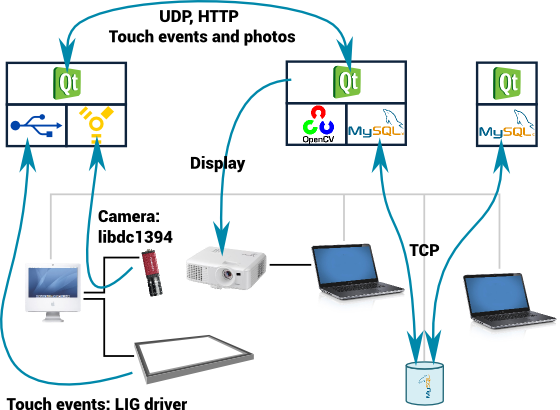Agile Touch: an augmented Scrum backlog
The idea
Thibault Friedrich is the one who came up with the concept of an augmented backlog for agile development. A standard backlog for Scrum methods is as simple as a blackboard on which developers stick Post-It notes. Thibault envisioned more:
Agile Touch save the contents of the Post-Its, their position, their progress. This software improves greatly over the traditional backlog, with advantages such as:
- real-time backups
- distributed use
- desktop version
- augmented reality
I became part of this project after he decided to implement it and submitted his idea as an end-of-second-year project. Our four-student team turned his design into a real thing, and it worked very well, as you can see in the following video demonstration.
Peripherals and architectural overview
The touch-enabled blackboard is provided by an old DiamondTouch device lent by the User Interface laboratory of Grenoble. Photos of Post-Its are taken using a Marlin telecamera. These two devices need an Apple computer to run: one because the drivers we had are mac-only, and the other because it uses a Firewire cable. Then the main application is hosted on the Linux PC of one of the team members, which is connected to the video projector. It also host the database where post-its are stored. Finally a third PC is used to emulate distant use cases.
We did the real thing: the application is designed in such a way that it could really be used by several distant teams.

All the code was written in C++, except for the drivers which were already available in Objective C.
We based all our software architecture on top of the Qt framework. It provides our graphical interface, our network stack and database access. We also used OpenCV to do the image processing part. I worked mostly on the algorithm to extract Post-Its using OpenCV, and on the network part between the DiamondTouch device and the main PC. I also spent a lot of time debugging code and working around some of the problems we encountered.
From left to right: original photo, border detection, square detection, homography, thresholding and final result.

The Qt framework, the bad Apple and the ugly drivers
We stumbled upon many problems while implementing our project. The most annoying ones revolved around our need for an Apple computer. At first we were given an old PowerPC server, which we had to compile our project on. To make it work, I learned how to use the CMake build system, and wrote a set of CMakeLists files which could select the right parts of the project to compile depending on the target architecture. That was a bit tricky, because the program we wrote for the Mac was linked against both our Qt/C++ architecture and the Objective C/Apple drivers. But in the end (and after countless hours of compilation for the whole Qt library), it worked.
![]()
Fear this icon.
The next day, the hard drive gave its last spin away, and we had to switch to a newer iMac with a brand new 64bits Intel processor. Unfortunately, the drivers for the peripherals were not ready for such a big step forward: they were 32bit only, which required a new round of CMake witchcraft to deal with.
The end
You may find information about other aspects of this project on the websites of other team members:
- Thibault Friedrich
- Youcef Mammar
- Cyril Lorenzetto